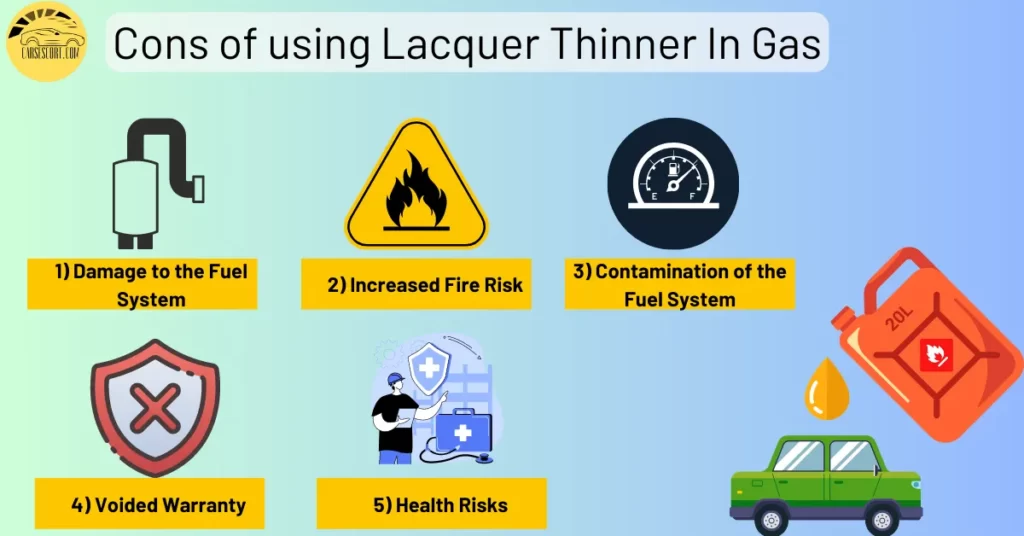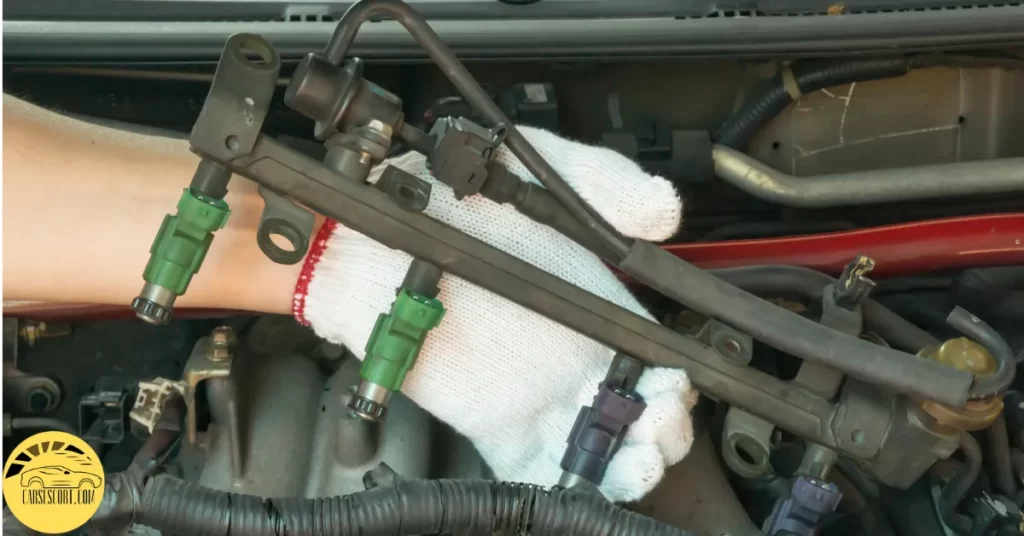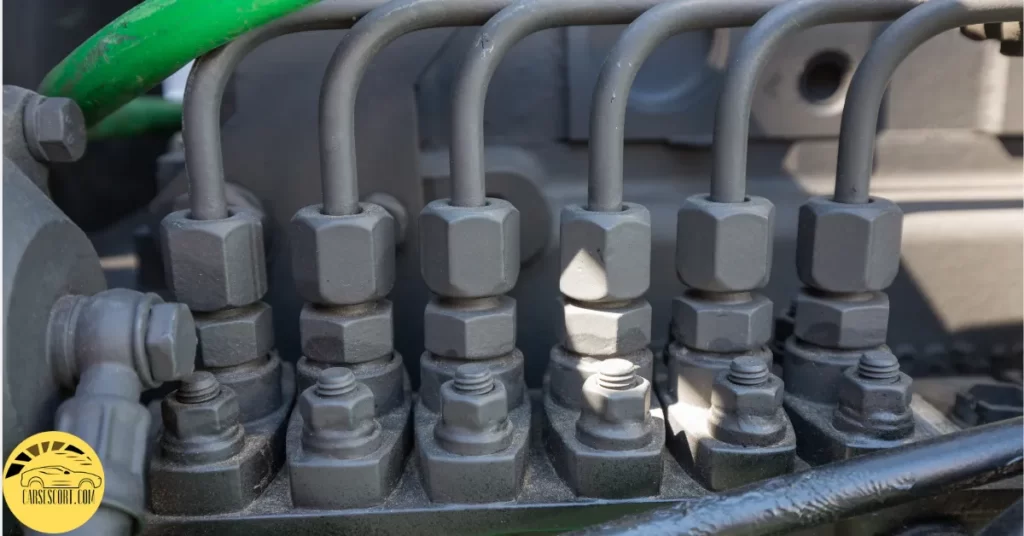When added to a gas tank, lacquer thinner may dissolve the protective lining on the fuel system and lead to corrosion, leaks, and other issues.
Adding lacquer thinner also known as cellulose thinner to a gas tank may seem like a quick fix for some engine problems, but it can cause significant damage to the vehicle. It is a powerful solvent typically used to remove paint and other coatings.
Key Takeaways:
- It is not safe to put lacquer thinner in a gas tank.
- In 75% of cases, thinner will ruin your car fuel system and essential engine components made of rubber and plastic.
- It may dissolve the protective lining and lead to corrosion, leaks, and other issues.
- Can also introduce contaminants into the fuel system, clogging injectors and other components.
- Pouring lacquer thinner in your gas tank can clean catalytic converters when used with caution and proper techniques.
Can You Put Lacquer Thinner in gas tank?
Never put lacquer thinner in your gas tank.
The lacquer thinner is a highly potent solvent that can dissolve various coatings and materials, including the protective lining in the fuel system, when used improperly and can lead to severe damage, such as leaks, corrosion, and other issues that can ultimately result in costly repairs or even total engine failure.
Is It Safe To Use Lacquer Thinner In Gas Tank?
The safety of using lacquer thinner in your vehicle gas tank for cleaning the catalytic converter or other purposes depends on how it is used. However, in general, it is not safe and not recommended. Using cellulose thinner in gas tanks has short-term benefits but may have long terms consequences.
Some professional mechanics believe that pouring lacquer thinner with caution and proper techniques in your car’s gas tank can help address specific engine issues, such as clogged catalytic converters, fuel injectors, exhaust valves, or dirty carburetors.
However, improper solvent use can dissolve the protective lining on the fuel system and lead to corrosion, leaks, and other issues, including exhaust and cat damage.

Cons of using Lacquer Thinner In Gas
1) Damage to the Fuel System
Lacquer thinner is a potent solvent that can dissolve various materials, including the protective lining in the gas system and exhaust system, which can lead to corrosion, leaks, and other issues that can cause significant damage to the vehicle’s fuel system and engine.
2) Increased Fire Risk
Cellulose thinner is highly flammable and combustible; adding it to a gas tank can increase the risk of fire and explosions. Especially true if the vehicle is running or if there are any sparks or flames nearby.
3) Contamination of the Fuel System
Lacquer thinner can also introduce contaminants into the car’s fuel system, clogging gas injectors and other components, leading to reduced car engine performance, fuel pressure regulator performance, decreased gas efficiency, and other issues.

4) Voided Warranty
Most car manufacturers explicitly prohibit using solvents or additives not approved by the manufacturer. Adding thinner to a gas tank can void the vehicle’s warranty and potentially cause issues with insurance coverage.
5) Health Risks
Cellulose thinner can also be hazardous to human health, causing skin and eye irritation, dizziness, headaches, and other symptoms.
Handling this chemical carefully and avoid direct contact with the solvent or inhalation of its fumes is essential.
Can You Put Lacquer Thinner In Gas Tank To Clean Your Catalytic Converter?
No, putting lacquer thinner in your gas tank is not recommended to clean your catalytic converter.
You may have here it from someone or have watched a video on YouTube that using lacquer thinner in your gas tank can clean catalytic converters. No doubt, sometimes it may work fine without any damage.
However, in 75% of cases, by doing this, you are ruining your car fuel system, exhaust system and essential engine components specially made of rubber and plastic.
Read: How To Unclog a Catalytic Converter Without Removing It?
Sings of Lacquer Thinner in Car Fuel
Using lacquer thinner in car fuel can have serious negative consequences and is not recommended.
Signs that cellulose thinner has been added to car gas may include:
1) Strong Odor
Lacquer thinner has a robust and distinctive odor that can be detected. If you notice a strong chemical smell coming from your car’s fuel, it could indicate that thinner has been added.
2) Engine Running Poorly
Using cellulose thinner in vehicle gas can damage the engine and cause it to run poorly. If your car’s engine is running rough, misfiring, or stalling, it could signal lacquer thinner in the fuel.
3) Smoke or Fumes
Adding thinner to car fuel can cause smoky exhaust or toxic fumes from the exhaust. If you notice thick smoke or unusual fumes coming from your car’s exhaust, it could indicate that lacquer thinner has been added to the gas.
4) Damage to Fuel System Components
Using lacquer thinner in car can cause damage to fuel system components such as the fuel pump, filter, and injectors.
If you experience issues with these components, it could be a sign that cellulose thinner has been added to the gas.

How To Remove Lacquer Thinner From Gas Tank?
Removing lacquer thinner from a gas tank can be a challenging task. However, below we have mentioned several steps you can take to safely and effectively get rid of it:
- Begin by completely draining any remaining fuel or lacquer thinner. You can use a siphon pump or remove the tank and pour the contents.
- Remove the gas tank from the vehicle to make cleaning easier.
- Choose a well-ventilated area to avoid inhaling fumes.
- Rinse the gas tank thoroughly to remove any remaining cellulose thinner. You can use a hose or pressure washer for this step.
- To clean the tank further, add a mixture of hot water and dish soap or a specialized gas tank cleaning solution. Follow the instructions on the product carefully.
- Use a long-handled scrub brush to clean the inside of the tank, making sure to reach all corners and crevices.
- Once the tank has been scrubbed, rinse it thoroughly with water to remove any cleaning solution or debris.
- Dry the tank entirely before re-installing it to prevent rust and corrosion. Use a clean, dry towel or allow the tank to air-dry.
How Do You Use Lacquer Thinner on a Car?
- Wear protective gloves and safety glasses to prevent any contact with the skin or eyes.
- Choose a well-ventilated area, preferably outdoors, to avoid inhaling fumes from the lacquer thinner.
- Pour some thinner onto a clean, lint-free cloth or rag.
- Test a small, inconspicuous area of the car’s paint to ensure the thinner does not damage the finish.
- Gently rub the cloth over the paint’s surface, working in small sections.
- After cleaning each section, use a clean cloth or rag to remove any residue.
- Repeat the process until the entire car has been cleaned.
- Rinse the car thoroughly with water and exterior-friendly soap to remove any remaining traces of cellulose thinner.
What is a Substitute for Lacquer Thinner?
If you need a substitute for lacquer thinner, there are a few options that you can consider. However, not all substitutes will work for all applications and materials, and some may not be as effective as thinner.
1) Mineral Spirits
Mineral spirits are a common alternative to lacquer thinner and are generally less harsh and less volatile. They are often used to thin oil-based paints, clean brushes, and other tools and remove wax or grease from surfaces.
2) Denatured Alcohol
Denatured alcohol is often used as a cleaner, degreaser, or thinner for shellac, lacquer, and other finishes. It can also remove ink, adhesive residue, and stains.
3) Isopropyl Alcohol
Isopropyl alcohol is a common solvent that is used for cleaning and disinfecting, as well as for removing grease, oil, or ink from surfaces.
It is generally less aggressive than thinner or acetone and is safe for most materials.
FAQ
Does lacquer thinner work on catalytic converters?
No, lacquer thinner should not be used on catalytic converters as it can damage the catalyst and affect its performance.
Will a gas engine run on paint thinner?
No, paint thinner is not suitable for gas engines.
Can I use thinner as fuel?
No, thinner should not be used as fuel as it is unsuitable for combustion and can cause engine damage or failure.
Is lacquer thinner good for your car?
No, lacquer thinner should not be used on your car as it can damage the paint, plastic, and rubber parts.
How Much Lacquer Thinner Be Used For Cleaning?
The amount of lacquer thinner to be used for cleaning depends on the size of the area and the level of dirt and grime. It is recommended to start with a less amount and increase gradually as needed.
Following the manufacturer’s instructions and safety precautions when using cellulose thinner is essential.
Affiliate Disclosure: Cars Escort is a participant in the Amazon Services LLC Associates Program. As an Amazon Associate, we earn from qualifying purchases made through affiliate links on our site. Read Our Disclaimer .

